Messier Monday: The Globular that Almost Didn’t Make it, M107
But with its gaps and unusual structure, we’re lucky it did.
“But touch a solemn truth in collision with a dogma of a sect, though capable of the clearest proof, and you will find you have disturbed a nest, and the hornets will swarm about your eyes and hand, and fly into your face and eyes.” -John Adams
Every week for almost two years now, we’ve been taking a look at one of the fixed, deep-sky objects that make up the Messier catalogue. Back in the 18th century, skywatchers knew about stars, planets, the Milky Way, and the existence of comets. There were a few star clusters and faint, fuzzy objects that seemed to be fixed in the sky, but were often confused with comets. Charles Messier set out to make a comprehensive catalogue of these fixed objects to avoid potential confusion for comet hunters, but what we wound up with today is a spectacular catalogue of 110 of the best nebulae, clusters, and galaxies visible to amateur and professional astronomers alike from here on Earth.
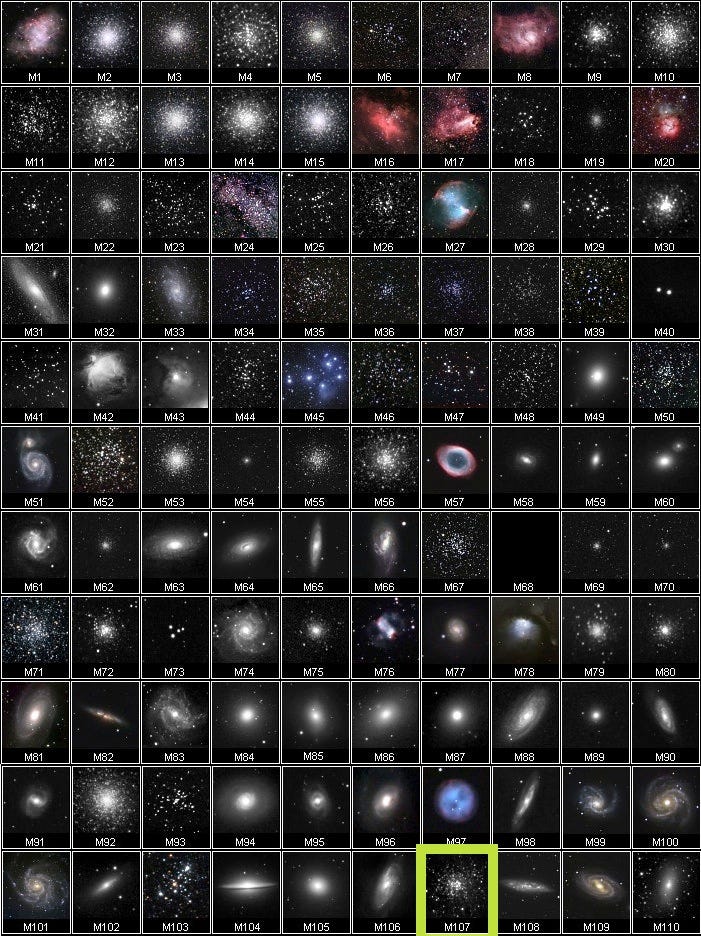
The original catalogue consisted of 103 objects and was published in 1781. However, Messier and his assistant, Pierre Méchain, identified and catalogued some additional objects that were posthumously added to the catalogue in the 20th century. Today’s object — Messier 107 — has the unique distinction of being the last object discovered chronologically, and is the very last globular cluster in the catalogue.
Here’s how to find it.
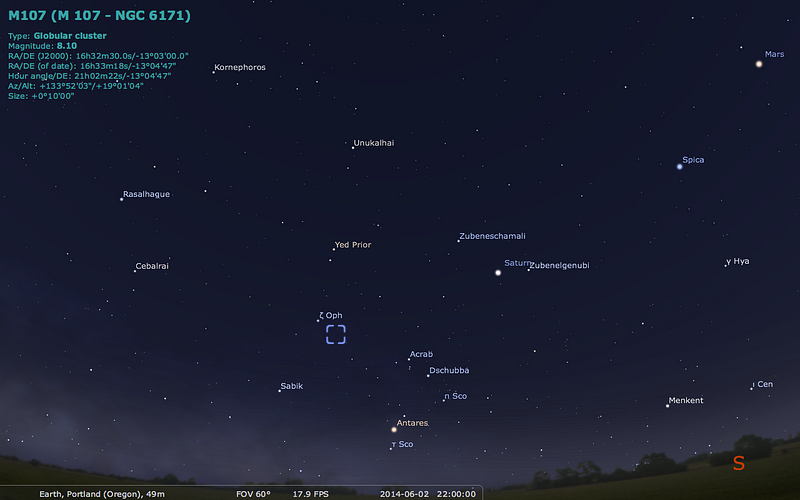
As the summer comes on in the Northern Hemisphere, a new set of objects becomes visible in the southern and eastern parts of the sky; object that are invisible at other times of the year. Shortly after sunset, if you look to the southeast part of the sky, bright Saturn dominates all the other points of light around it. But as far as fixed objects goes, the bright orange giant Antares is no slouch, the brightest star in the ancient constellation of Scorpius and sometimes known as “the rival of Mars” due to its bright orange hue.
Even though it’s technically in the constellation of Ophiuchus, Antares is your best bet for leading you to Messier 107.
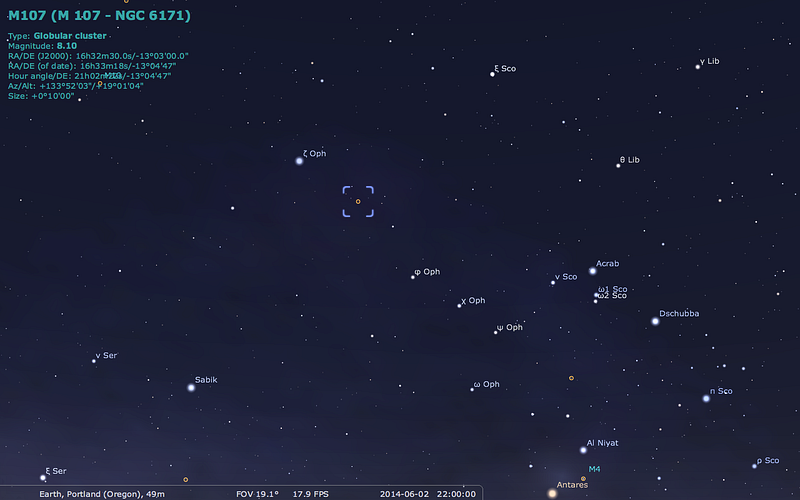
If you navigate farther above the horizon, a number of visibly naked-eye stars seem to make a rough line towards distant Rasalhague, the brightest star in Ophiuchus, but it’s the brighter one almost halfway from Antares to Rasalhague — Zeta (ζ) Ophiuchi — that will lead you very clearly to Messier 107. Even on a night light tonight, where the Moon is out and light pollution is severe, globular clusters like this one make an outstanding target.
If you can center your optics on ζ Ophiuchi, you’ll be well on your way.
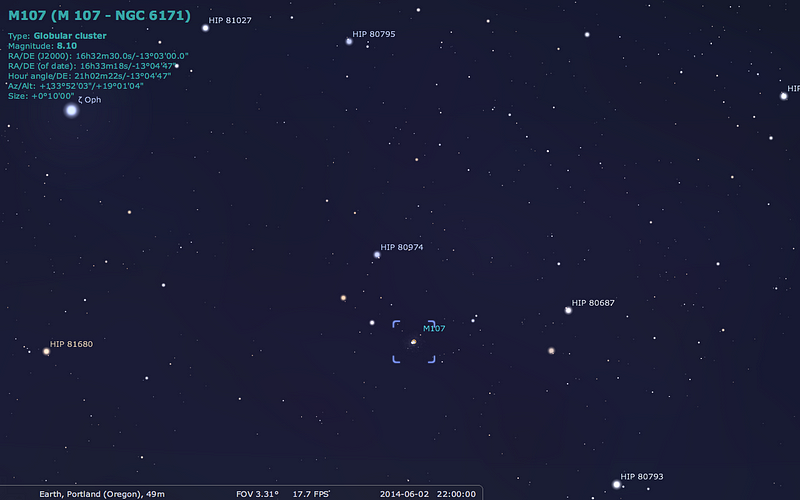
Roughly two degrees back towards Antares (or a little under halfway back to the slightly dimmer star, φ Ophiuchi), is this little gem, the last Messier object to be discovered, by Méchain in 1782. Writing in a letter to Bernoulli the next year, he articulated the following:
In April 1782 I discovered a small nebula in the left flank of Ophiuchus between the stars Zeta and Phi, the position of which I have not yet observed any closer.
That was the first mention of this object, and through a small telescope it looks merely like a dense collection of stars.

It is, of course, a dense collection of stars, but despite appearing just on the edge of the galactic plane, it isn’t part of our galaxy at all!
At a distance of around 21,000 light years, this is one of the closest globular clusters in existence to Earth, a system with hundreds of thousands of stars condensed into a region just 80 light-years in diameter, or less than 20 times the distance from our Sun to the next nearest star.
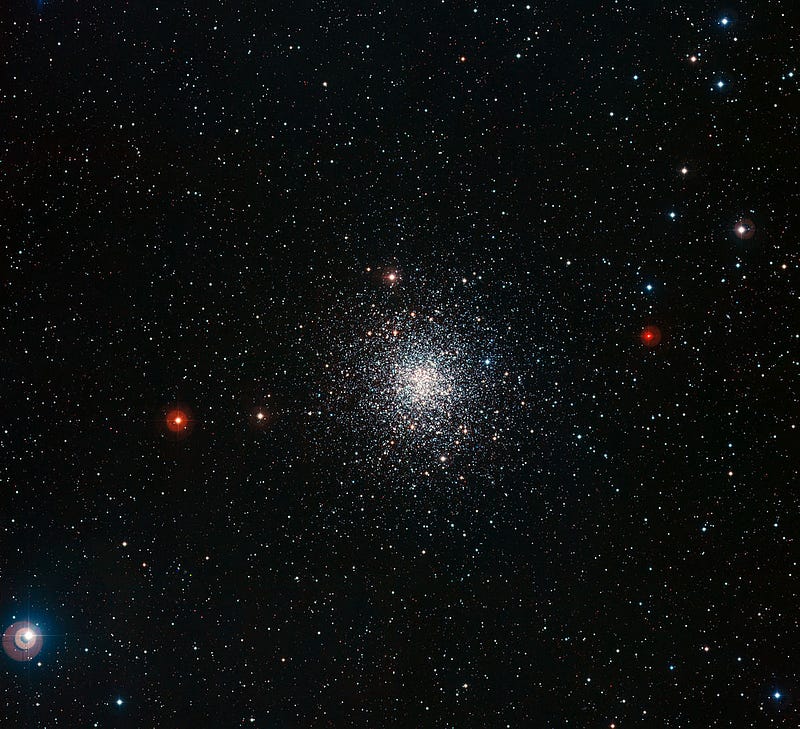
There are a large number of blue stars in here, which may come as some surprise: blue stars are typically young, and globular clusters tend to be old. However, blue stars are actually quite common in these objects; as old, faint stars eventually merge together in these dense stellar swarms, they form a new type of star known as a blue straggler. Even though they only live a short while, they replenish themselves rapidly enough that most globular clusters contain a large population of them, especially towards the center.

Some globular clusters are among the oldest in the Universe, many of them containing less than 1% the amount of heavy elements (like iron) that our Sun has. But this one, we’re sure, formed much later than that; it has 11% the amount of heavy elements our Sun does, meaning that it didn’t form until the Universe was already many billions of years old!
This is rare for a globular cluster in our galaxy’s halo; either it was stolen from a smaller galaxy in a merger or it formed in a tremendous burst of star formation much later than the rest of them!
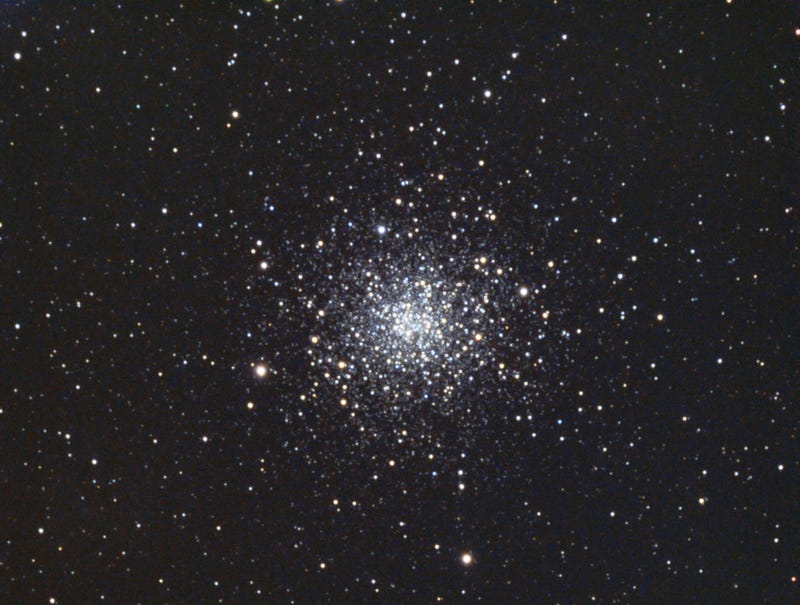
It has some strange-looking dark spots around it, incredibly unusual for a globular cluster. Is that because there aren’t stars there?
Not at all! It’s due to some foreground effects; the outskirts of the plane of the galaxy is in between this cluster and us, and where there’s a little bit of light-blocking dust, it appears that the stellar density is dramatically reduced.
But looking in the infrared will clear that right up!
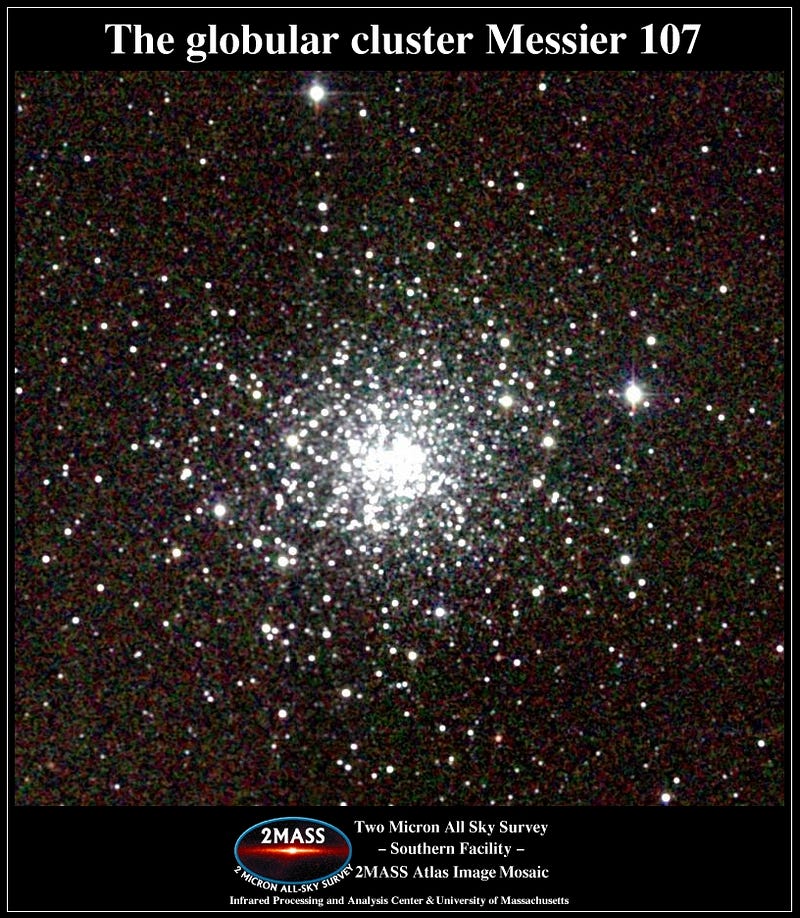
Many of you often wonder what the night sky would look like from within one of these globular clusters. When you think of our night sky, I want you to think of the brightest stars that you commonly see. As it turns out, the brightest stars in this globular cluster would appear of comparable brightness to them.
Only, instead of maybe a few dozen that are that bright, there would be thousands.
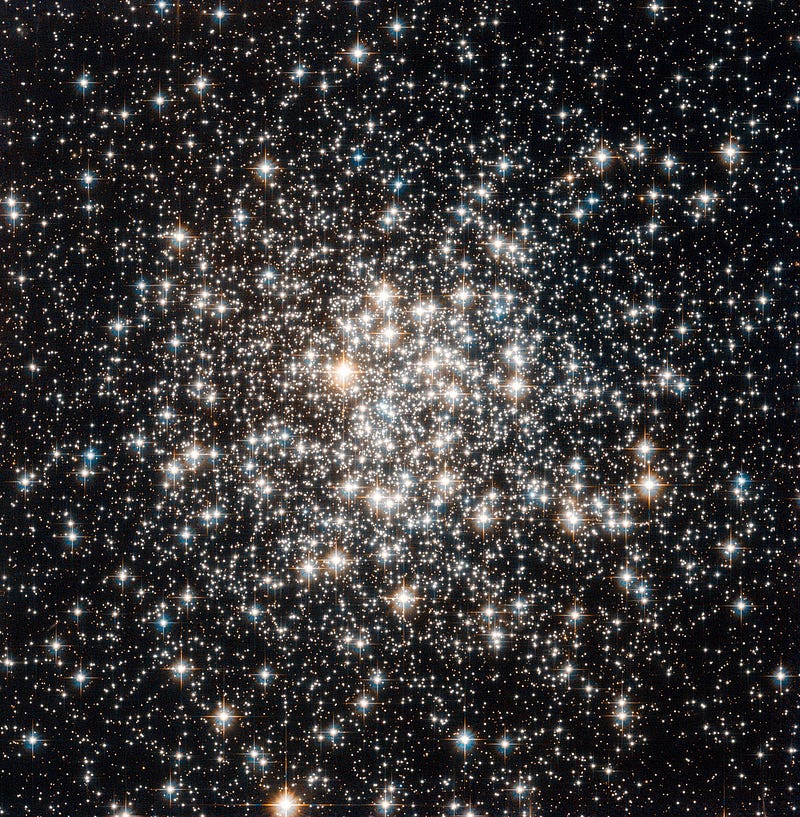
When the orientation was just right, this represents a view of what you might see overhead.
Of course, we can — thanks to Hubble — peer deep inside the very core of this cluster. As you’d expect, it’s full of stars… but what Hubble allows us to see never ceases to amaze me!

Every star in there has its own Solar System, has been around for far longer than our Sun has, and — despite its advanced age and chaotic environment — at least a chance for life. And remember, when you look at this incredible stellar cluster, this is one of the least dense globulars out there, rating a class X on a scale of I-XII to determine its density. Who knows what lives inside a globular cluster? Right now, all we have is our imaginations.
And with that, we come to the end of another Messier Monday. Including today’s entry, we’ve looked at the following list of Messier objects, below:
- M1, The Crab Nebula: October 22, 2012
- M2, Messier’s First Globular Cluster: June 17, 2013
- M3, Messier’s First Original Discovery: February 17, 2014
- M4, A Cinco de Mayo Special: May 5, 2014
- M5, A Hyper-Smooth Globular Cluster: May 20, 2013
- M7, The Most Southerly Messier Object: July 8, 2013
- M8, The Lagoon Nebula: November 5, 2012
- M10, A Perfect Ten on the Celestial Equator: May 12, 2014
- M11, The Wild Duck Cluster: September 9, 2013
- M12, The Top-Heavy Gumball Globular: August 26, 2013
- M13, The Great Globular Cluster in Hercules: December 31, 2012
- M15, An Ancient Globular Cluster: November 12, 2012
- M18, A Well-Hidden, Young Star Cluster: August 5, 2013
- M20, The Youngest Star-Forming Region, The Trifid Nebula: May 6, 2013
- M21, A Baby Open Cluster in the Galactic Plane: June 24, 2013
- M25, A Dusty Open Cluster for Everyone: April 8, 2013
- M29, A Young Open Cluster in the Summer Triangle: June 3, 2013
- M30, A Straggling Globular Cluster: November 26, 2012
- M31, Andromeda, the Object that Opened Up the Universe: September 2, 2013
- M32, The Smallest Messier Galaxy: November 4, 2013
- M33, The Triangulum Galaxy: February 25, 2013
- M34, A Bright, Close Delight of the Winter Skies: October 14, 2013
- M36, A High-Flying Cluster in the Winter Skies: November 18, 2013
- M37, A Rich Open Star Cluster: December 3, 2012
- M38, A Real-Life Pi-in-the-Sky Cluster: April 29, 2013
- M39, The Closest Messier Original: November 11, 2013
- M40, Messier’s Greatest Mistake: April 1, 2013
- M41, The Dog Star’s Secret Neighbor: January 7, 2013
- M42, The Great Orion Nebula: February 3, 2014
- M44, The Beehive Cluster / Praesepe: December 24, 2012
- M45, The Pleiades: October 29, 2012
- M46, The ‘Little Sister’ Cluster: December 23, 2013
- M47, A Big, Blue, Bright Baby Cluster: December 16, 2013
- M48, A Lost-and-Found Star Cluster: February 11, 2013
- M49, Virgo’s Brightest Galaxy: March 3, 2014
- M50, Brilliant Stars for a Winter’s Night: December 2, 2013
- M51, The Whirlpool Galaxy: April 15th, 2013
- M52, A Star Cluster on the Bubble: March 4, 2013
- M53, The Most Northern Galactic Globular: February 18, 2013
- M56, The Methuselah of Messier Objects: August 12, 2013
- M57, The Ring Nebula: July 1, 2013
- M58, The Farthest Messier Object (for now): April 7, 2014
- M59, An Elliptical Rotating Wrongly: April 28, 2014
- M60, The Gateway Galaxy to Virgo: February 4, 2013
- M61, A Star-Forming Spiral: April 14, 2014
- M63, The Sunflower Galaxy: January 6, 2014
- M64, The Black Eye Galaxy: February 24, 2014
- M65, The First Messier Supernova of 2013: March 25, 2013
- M66, The King of the Leo Triplet: January 27, 2014
- M67, Messier’s Oldest Open Cluster: January 14, 2013
- M68, The Wrong-Way Globular Cluster: March 17, 2014
- M71, A Very Unusual Globular Cluster: July 15, 2013
- M72, A Diffuse, Distant Globular at the End-of-the-Marathon: March 18, 2013
- M73, A Four-Star Controversy Resolved: October 21, 2013
- M74, The Phantom Galaxy at the Beginning-of-the-Marathon: March 11, 2013
- M75, The Most Concentrated Messier Globular: September 23, 2013
- M77, A Secretly Active Spiral Galaxy: October 7, 2013
- M78, A Reflection Nebula: December 10, 2012
- M79, A Cluster Beyond Our Galaxy: November 25, 2013
- M81, Bode’s Galaxy: November 19, 2012
- M82, The Cigar Galaxy: May 13, 2013
- M83, The Southern Pinwheel Galaxy, January 21, 2013
- M84, The Galaxy at the Head-of-the-Chain, May 26, 2014
- M85, The Most Northern Member of the Virgo Cluster, February 10, 2014
- M86, The Most Blueshifted Messier Object, June 10, 2013
- M87, The Biggest One of them All, March 31, 2014
- M88, A Perfectly Calm Spiral in a Gravitational Storm, March 24, 2014
- M90, The Better-You-Look, The Better-It-Gets Galaxy, May 19, 2014
- M92, The Second Greatest Globular in Hercules, April 22, 2013
- M93, Messier’s Last Original Open Cluster, January 13, 2014
- M94, A double-ringed mystery galaxy, August 19, 2013
- M95, A Barred Spiral Eye Gazing At Us, January 20, 2014
- M96, A Galactic Highlight to Ring in the New Year, December 30, 2013
- M97, The Owl Nebula, January 28, 2013
- M98, A Spiral Sliver Headed Our Way, March 10, 2014
- M99, The Great Pinwheel of Virgo, July 29, 2013
- M101, The Pinwheel Galaxy, October 28, 2013
- M102, A Great Galactic Controversy: December 17, 2012
- M103, The Last ‘Original’ Object: September 16, 2013
- M104, The Sombrero Galaxy: May 27, 2013
- M105, A Most Unusual Elliptical: April 21, 2014
- M106, A Spiral with an Active Black Hole: December 9, 2013
- M107, The Globular that Almost Didn’t Make it: June 2, 2014
- M108, A Galactic Sliver in the Big Dipper: July 22, 2013
- M109, The Farthest Messier Spiral: September 30, 2013
Come back next week for another star-filled delight of the night sky fit for a bright Moon, only here on Messier Monday!
Enjoyed this? Leave a comment on the Starts With A Bang forum at Scienceblogs!





